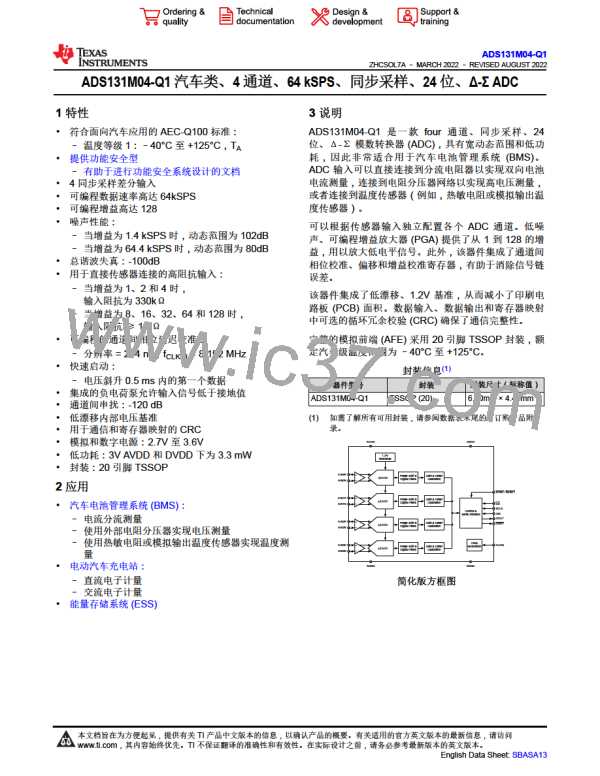ADS131M04-Q1
ZHCSOL7A –MARCH 2022 –REVISED AUGUST 2022
www.ti.com.cn
the first samples immediately following start up, ignore the first two instances of DRDY toggling from high to low
and begin collecting data on the third instance.
The start-up process following a RESET command or a pin reset using the SYNC/RESET pin is similar to what
occurs after power up. However there is no tPOR in the case of a command or pin reset because the supplies are
already ramped. After reset, the device waits for the initial wait time delay of (256 + 44) × tMOD before providing
modulator samples to the two digital filters. The fast-settling filter is enabled for the first two output samples.
8.4.3 Conversion Modes
There are two ADC conversion modes on the ADS131M04-Q1: continuous-conversion and global-chop mode.
Continuous-conversion mode is a mode where ADC conversions are generated constantly by the ADC at a rate
defined by fMOD / OSR. Global-chop mode differs from continuous-conversion mode because global-chop
periodically chops (or swaps) the inputs, which reduces system offset errors at the cost of settling time between
the points when the inputs are swapped. In either continuous-conversion or global-chop mode, there are three
power modes that provide flexible options to scale power consumption with bandwidth and dynamic range. The
Power Modes section discusses these power modes in further detail.
8.4.3.1 Continuous-Conversion Mode
Continuous-conversion mode is the mode in which ADC data are generated constantly at the rate of fMOD / OSR.
New data are indicated by a DRDY falling edge at this rate. Continuous-conversion mode is intended for
measuring AC signals because this mode allows for higher output data rates than global-chop mode.
8.4.3.2 Global-Chop Mode
The ADS131M04-Q1 incorporates a global-chop mode option to reduce offset error and offset drift inherent to
the device resulting from mismatch in the internal circuitry to very low levels. When global-chop mode is enabled
by setting the GC_EN bit in the GLOBAL_CHOP_CFG register, the device uses the conversion results from two
consecutive internal conversions taken with opposite input polarity to cancel the device offset voltage.
Conversion n is taken with normal input polarity. The device then reverses the internal input polarity for
conversion n + 1. The average of two consecutive conversions (n and n + 1, n + 1 and n + 2 and so on) yields
the final offset compensated result.
图 8-15 shows a block diagram of the global-chop mode implementation. The combined PGA and ADC internal
offset voltage is modeled as VOFS. Only this device inherent offset voltage is reduced by global-chop mode.
Offset in the external circuitry connected to the analog inputs is not affected by global-chop mode.
GC_EN
Chop Switch
VOFS
-
+
AINnP
AINnN
C
A D
Digital
Filter
Global-Chop
Mode Control
PGA
ADC
Conversion Output
图8-15. Global-Chop Mode Implementation
The conversion period in global-chop mode differs from the conversion time when global-chop mode is disabled
(tDATA = OSR x tMOD). 图8-16 shows the conversion timing for an ADC channel using global-chop mode.
Global-chop delay
Modulator sampling
1st global-chop
conversion result
2nd global-chop
conversion result
Conversion
start
Data not
settled
Data not
settled
Swap inputs,
digital filter reset
Data not
settled
Data not
settled
ADC overhead
Sampling
n
Sampling
n
Sampling
n
Sampling
n + 1
Sampling
n + 1
Sampling
n + 1
Sampling
n + 2
Sampling
n + 2
Sampling
n + 2
Sampling
n + 3
Sampling
n + 3
Sampling
n + 3
tGC_FIRST
tGC_CONVERSION
tDATA
CONVERSION
图8-16. Conversion Timing With Global-Chop Mode Enabled
Copyright © 2022 Texas Instruments Incorporated
32
Submit Document Feedback
Product Folder Links: ADS131M04-Q1

 TI [ TEXAS INSTRUMENTS ]
TI [ TEXAS INSTRUMENTS ]